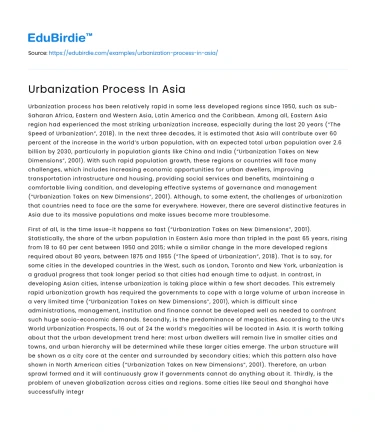Urbanization process has been relatively rapid in some less developed regions since 1950, such as sub-Saharan Africa, Eastern and Western Asia, Latin America and the Caribbean. Among all, Eastern Asia region had experienced the most striking urbanization increase, especially during the last 20 years (“The Speed of Urbanization”, 2018). In the next three decades, it is estimated that Asia will contribute over 60 percent of the increase in the world’s urban population, with an expected total urban population over 2.6 billion by 2030, particularly in population giants like China and India (“Urbanization Takes on New Dimensions”, 2001). With such rapid population growth, these regions or countries will face many challenges, which includes increasing economic opportunities for urban dwellers, improving transportation infrastructure and housing, providing social services and benefits, maintaining a comfortable living condition, and developing effective systems of governance and management (“Urbanization Takes on New Dimensions”, 2001). Although, to some extent, the challenges of urbanization that countries need to face are the same for everywhere. However, there are several distinctive features in Asia due to its massive populations and make issues become more troublesome.
First of all, is the time issue-it happens so fast (“Urbanization Takes on New Dimensions”, 2001). Statistically, the share of the urban population in Eastern Asia more than tripled in the past 65 years, rising from 18 to 60 per cent between 1950 and 2015; while a similar change in the more developed regions required about 80 years, between 1875 and 1955 (“The Speed of Urbanization”, 2018). That is to say, for some cities in the developed countries in the West, such as London, Toronto and New York, urbanization is a gradual progress that took longer period so that cities had enough time to adjust. In contrast, in developing Asian cities, intense urbanization is taking place within a few short decades. This extremely rapid urbanization growth has required the governments to cope with a large volume of urban increase in a very limited time (“Urbanization Takes on New Dimensions”, 2001), which is difficult since administrations, management, institution and finance cannot be developed well as needed to confront such huge socio-economic demands. Secondly, is the predominance of megacities. According to the UN’s World Urbanization Prospects, 16 out of 24 the world’s megacities will be located in Asia. It is worth talking about that the urban development trend here: most urban dwellers will remain live in smaller cities and towns, and urban hierarchy will be determined while these larger cities emerge. The urban structure will be shown as a city core at the center and surrounded by secondary cities; which this pattern also have shown in North American cities (“Urbanization Takes on New Dimensions”, 2001). Therefore, an urban sprawl formed and it will continuously grow if governments cannot do anything about it. Thirdly, is the problem of uneven globalization across cities and regions. Some cities like Seoul and Shanghai have successfully integrated into the global economy and becoming leading international cites, while the other cities that are heavily dependent on domestic economies experience a much slower development. For these cities, they face greater challenge in terms of poverty and opportunity creation (“Urbanization Takes on New Dimensions”, 2001).
Save your time!
We can take care of your essay
- Proper editing and formatting
- Free revision, title page, and bibliography
- Flexible prices and money-back guarantee
Case of China
Now we take a close look at the case of urbanization in China, which is interesting to discuss about since China’s urbanization progress has been viewed as unique: it is neither identical with the developed economies nor following the same path of developing countries (Chen, Liu, & Tao, 2013). In the past 30 years, China's economy has grown explosively, which is a key pushing forward the urbanization process. In 1950, only 13% of people in China lived in cities. However, after 60 years, this number had grown to 45%. Up to today, 25 of the world’s largest 100 cities are in China. Urbanization, in turn, reshaps both the physical environment and the cultural fabric of China (Seto, 2016). For example, the issue of pollution and huge city demands on the environment, as well as opportunities and innovations and improving efficiency of energy usage caused by high density living conditions.
Like mentioned earlier, some challenges are globally identical, such as the problem of pollution. However, it has greater impacts for developing countries like China as their economic development often highly relies on industrial output. China obviously had tradeoffs between economic boom and environment. Years ago, images of Chinese cities in haze or under heavy smog captured whole world's’ attentions. According to a report done by the China’s Ministry of Environmental Protection in 2014, it reflected that only 8 of 74 monitored cities met air quality standards (Hernandez & Andres, 2015). Such serious air pollution is associated with intense usage of coal energy, which are used to generate electricity, power industrialization, and heat homes. It’s clear that coal energy did creat socio-economic benefits for millions of people but also has led to environmental degradation and air-polluted city environments.






 Stuck on your essay?
Stuck on your essay?

